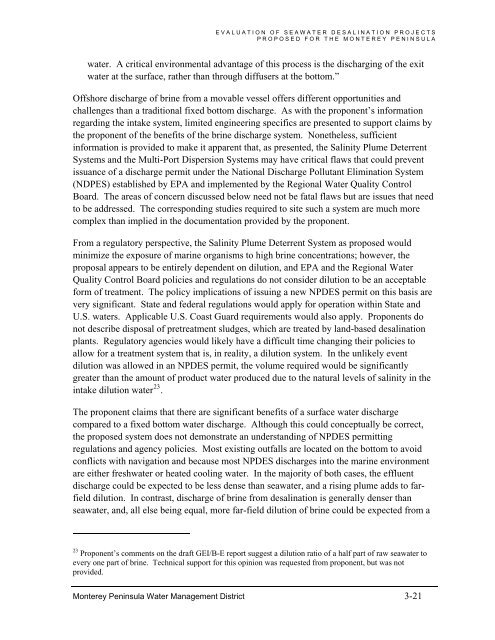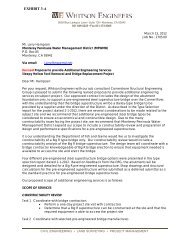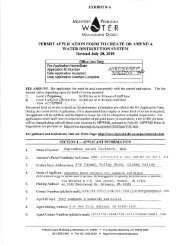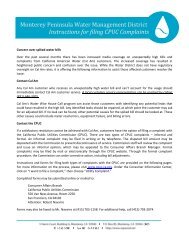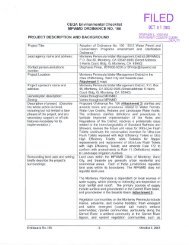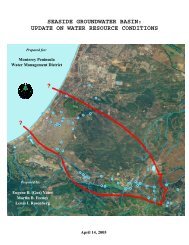FINAL REPORT Evaluation of Seawater Desalination Projects ...
FINAL REPORT Evaluation of Seawater Desalination Projects ...
FINAL REPORT Evaluation of Seawater Desalination Projects ...
Create successful ePaper yourself
Turn your PDF publications into a flip-book with our unique Google optimized e-Paper software.
EVALUATION OF SEAWATER DESALINATION PROJECTS<br />
PROPOSED FOR THE MONTEREY PENINSULA<br />
water. A critical environmental advantage <strong>of</strong> this process is the discharging <strong>of</strong> the exit<br />
water at the surface, rather than through diffusers at the bottom.”<br />
Offshore discharge <strong>of</strong> brine from a movable vessel <strong>of</strong>fers different opportunities and<br />
challenges than a traditional fixed bottom discharge. As with the proponent’s information<br />
regarding the intake system, limited engineering specifics are presented to support claims by<br />
the proponent <strong>of</strong> the benefits <strong>of</strong> the brine discharge system. Nonetheless, sufficient<br />
information is provided to make it apparent that, as presented, the Salinity Plume Deterrent<br />
Systems and the Multi-Port Dispersion Systems may have critical flaws that could prevent<br />
issuance <strong>of</strong> a discharge permit under the National Discharge Pollutant Elimination System<br />
(NDPES) established by EPA and implemented by the Regional Water Quality Control<br />
Board. The areas <strong>of</strong> concern discussed below need not be fatal flaws but are issues that need<br />
to be addressed. The corresponding studies required to site such a system are much more<br />
complex than implied in the documentation provided by the proponent.<br />
From a regulatory perspective, the Salinity Plume Deterrent System as proposed would<br />
minimize the exposure <strong>of</strong> marine organisms to high brine concentrations; however, the<br />
proposal appears to be entirely dependent on dilution, and EPA and the Regional Water<br />
Quality Control Board policies and regulations do not consider dilution to be an acceptable<br />
form <strong>of</strong> treatment. The policy implications <strong>of</strong> issuing a new NPDES permit on this basis are<br />
very significant. State and federal regulations would apply for operation within State and<br />
U.S. waters. Applicable U.S. Coast Guard requirements would also apply. Proponents do<br />
not describe disposal <strong>of</strong> pretreatment sludges, which are treated by land-based desalination<br />
plants. Regulatory agencies would likely have a difficult time changing their policies to<br />
allow for a treatment system that is, in reality, a dilution system. In the unlikely event<br />
dilution was allowed in an NPDES permit, the volume required would be significantly<br />
greater than the amount <strong>of</strong> product water produced due to the natural levels <strong>of</strong> salinity in the<br />
intake dilution water 23 .<br />
The proponent claims that there are significant benefits <strong>of</strong> a surface water discharge<br />
compared to a fixed bottom water discharge. Although this could conceptually be correct,<br />
the proposed system does not demonstrate an understanding <strong>of</strong> NPDES permitting<br />
regulations and agency policies. Most existing outfalls are located on the bottom to avoid<br />
conflicts with navigation and because most NPDES discharges into the marine environment<br />
are either freshwater or heated cooling water. In the majority <strong>of</strong> both cases, the effluent<br />
discharge could be expected to be less dense than seawater, and a rising plume adds to farfield<br />
dilution. In contrast, discharge <strong>of</strong> brine from desalination is generally denser than<br />
seawater, and, all else being equal, more far-field dilution <strong>of</strong> brine could be expected from a<br />
23 Proponent’s comments on the draft GEI/B-E report suggest a dilution ratio <strong>of</strong> a half part <strong>of</strong> raw seawater to<br />
every one part <strong>of</strong> brine. Technical support for this opinion was requested from proponent, but was not<br />
provided.<br />
Monterey Peninsula Water Management District 3-21


